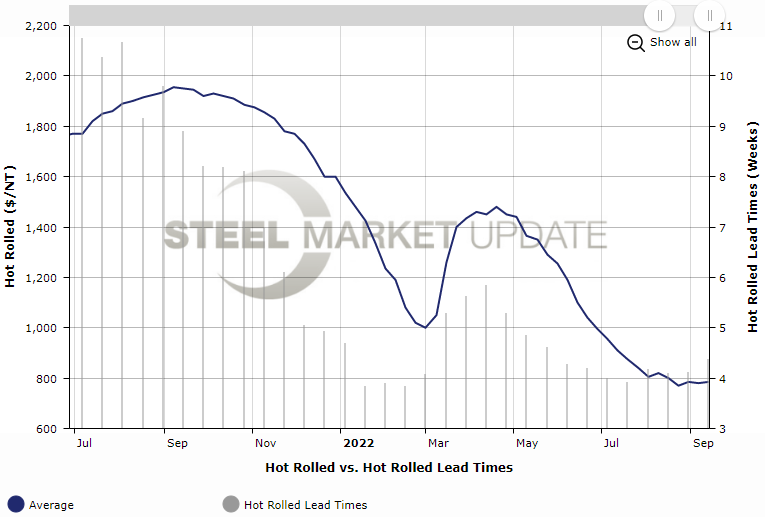Final Thoughts

Final Thoughts
Written by Michael Cowden
September 20, 2022
It’s contract negotiation season, and let’s just say that this year is a lot different than the last two years.
Mills had pricing power in contract talks in 2020 and in 2021. This year, buyers feel like they have more leverage—and they’re not being shy about pressing mills for lower prices.
On the one hand, you’ve got some buyers saying that we’re reverting to old pricing norms. Remember those bygone days when $600 per ton was a reasonable price for steel? On the other hand, you’ve got some producers insisting a new—or at least newish—higher normal is here to say.
If you’re a buyer, this is the year to show your boss you’re a tough negotiator. So we wouldn’t be surprised to see some musical chairs, with consumers more willing to switch suppliers if that’s what’s required to get a lower price.
Well, maybe that is the wrong way to look at it. It’s not necessarily that buyers are being more aggressive in negotiations. It might be more that they’re in no hurry to negotiate.
Sheet inventories were 2.34 months of supply in August, the last month for which we have complete data. That happens to be exactly what they were in August of 2021, according to the figures we’ve collected.
The difference? Hot-rolled coil lead times were nearly nine weeks this time last year. They’re roughly four weeks now, or less than half what they were a year ago. And recent channel checks indicate that a three-week lead time is hardly unheard of.
The gray bars in the chart below are lead times, the blue line is prices, which were a lot higher last year, too. (You can recreate this chart using our interactive pricing tool.)

In other words, you were staring down a late November lead time last year. And your inventory level meant you needed to restock or risk running dangerously low on supply. That’s not a strong point from which to negotiate.
This year, HRC lead times are more like mid/late October. You’ve got inventory to tide you over until then—and with plenty of tons to spare. That’s a much stronger position from which to launch contract talks.
Another reason some buyers might press hard, or simply wait, for a better deal is what might be a developing two-tier market. We continue to hear that very large orders placed with a domestic mill by several larger service centers last month are still impacting the market.
Think 50,000–150,000 tons—perhaps delivered over the course of several months—and placed in the $600s per ton. Those deals might not be on purely spot terms. And they might be repeatable for only a few buyers. That means they wouldn’t factor into our price range. But they do have a psychological impact on the market.
How do other mills react? Do they lower prices to compete, or do they scale back output? How do other buyers react? Do they buy only as needed until the broader market finds an equilibrium with those discounted tons?
I think we’re already seeing the answers to those question. US Steel very publicly announced the idling of the No. 8 blast furnace at its Gary Works in Northwest Indiana. That furnace has capacity of approximately 3,000 tons per day. That’s no small figure, roughly 360,000 tons through the end of the year.
And the number of tons taken out or soon to be taken out of the market gets higher fast if you include other idlings and outages—whether they’ve been made public or, more often, remained quiet. Keep in mind that taking a blast furnace down is often a very public affair. But an EAF producer can slow production or run fewer days without generating any headlines.
Buyers, meanwhile, can bide their time. Especially if demand—as appears to be the case—is softening. I know people who thought inventories would be aligned with demand by now. That’s probably not the case. Do things balance out in November or December?
The steel market tends to overreact on the way up and on the way down. SMU’s sentiment indicators have taken a turn for the worse, and you could make the case that if we were irrationally exuberant this time last year, then we’re irrationally dreary this year.
At some point, buyers will wait too long, and everyone will jump back into the market at the same time. But it doesn’t seem like we’re anywhere near that point yet.
By Michael Cowden, Michael@SteelMarketUpdate.com

Michael Cowden
Read more from Michael CowdenLatest in Final Thoughts

Final Thoughts
President Trump’s tariff policies have a lot more in common with a roundabout than you’d think.

Final Thoughts
The difference: The spat with Turkey was a big deal for steel. This time, the 50% reciprocal tariff for Brazil – if it goes into effect as threatened on Aug.1 – hits everything from coffee and to pig iron. It seems almost custom-built to inflict as much pain as possible on Brazil.

Final Thoughts
Are we on the cusp of sorting out the tariff situation, or is this merely another round in the bout?

Final Thoughts
I’m not sure how many different ways I can write that it’s been a quiet market ahead of Independence Day. There are variations on that theme. I’ve heard everything from the ominous “eerily quiet” to "getting better" and even the occasional “blissfully unaware” (because I’m enjoying my vacation).

Final Thoughts
What's going to be the next big thing in steel?
